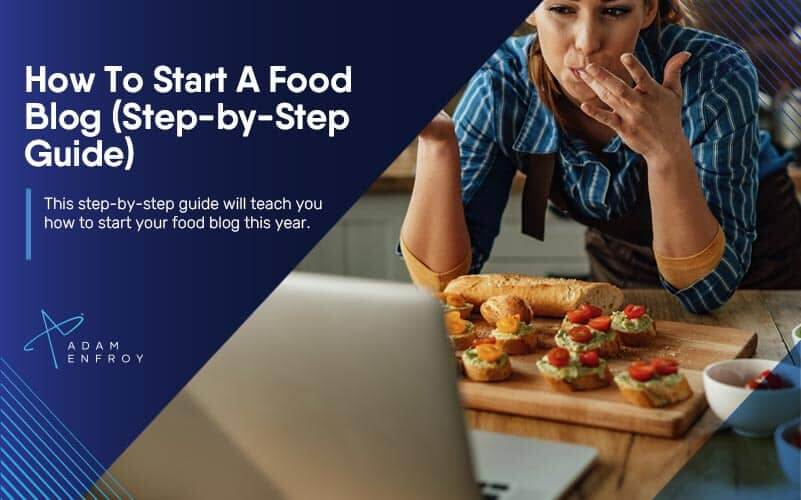How To Start A Profitable Food Blog (Step-by-Step Guide)

Do you love food with all your heart?
Do you want to share your passion for food with others but don’t know how?
Starting a blog can be intimidating, especially if it’s your first foray into online writing and digital media.
But the rewards can be immense — from growing a community of fellow food adventurers to generating income through affiliate marketing, sponsorships, or partnerships with local restaurants.

This step-by-step guide will teach you how to start your food blog this year.
Types Of Food Blogs
There are different food blogs, so deciding what content you want to create before you build your site is essential.
Do you want to focus on recipe development?
Or are you more interested in writing about restaurants and other food-related topics?
Maybe both?
Here are some of the best types of blogs to consider.
Recipe Blogs
A recipe and cooking blog is the most popular type of food blog.
It’s great for anyone who loves creating delicious dishes and introducing readers to new ingredients, flavors, or techniques.
You could provide a step-by-step guide to preparing delicious dishes, from gluten-free recipes to vegan options and healthy meal ideas.
With the ability to create a video tutorial to accompany your written instructions, recipe blogs are trendy.
Plugins like WP Recipe Maker help food bloggers manage their recipes and display them in an attractive and easy-to-navigate format.
Restaurant Reviews
For first-time foodies, a restaurant review blog is a perfect way to discuss your latest dining experiences.
Focusing on high-quality food photos and helpful tips related to where to go for good eats, these blogs are great for showcasing all the best restaurants in your area.
As a new food blog, you’ll want to research restaurants before writing reviews.
You can dig into customer ratings, or trying out dishes can give you a better understanding of what makes a restaurant stand out (or fall short).
Food Photography Blogs
Custom fonts and striking visuals are vital in setting your own food blog apart from others.
Within the food blog niche, a photography blog is ideal for the foodie that loves capturing beautiful images of their favorite dishes.
This type of blog still requires hard work to ensure you present photos attractively.
However, this could be the perfect outlet for showcasing your skills if you have a knack for taking great pictures.
Food Travel Blogs
This type of blog can have tons of customization and potential for growth.
As a food travel blogger, you could document your culinary journeys worldwide.
As you add new recipes based on your travels, you’ll also be able to share stories about regional dishes, must-visit restaurants, and other experiences related to the local cuisine.
In addition, social media platforms allow for the quick and easy sharing of photos and stories from your travels.
With excellent work, you can have a successful food blog that gives readers a virtual tour of the tastiest destinations around the globe.
Healthy Or Diet-Specific Blogs
Based on specific keyword research you might do, you could find that there’s an interest in health-focused food blogs.
Having a target audience that’s super niched and interested in one type of diet (such as veganism) could make it easier to develop content related specifically to their needs.
You can focus on recipes’ nutritional facts and create other content around healthy eating.
Ensure you have a user-friendly WordPress blog that makes the user experience as seamless as possible.
Steps To Starting A Food Blog
Here are the steps to get your food blog up and running.
Choose Your Niche
Choosing your blog niche is the first step to creating a successful food blog.
From using Google Adsense to getting sponsorships on your blog, defining your niche is essential for generating income.
Brainstorm Potential Blog Ideas
Brainstorming the type and quantity of posts you could produce around a given topic is key to having an effective blogging strategy.
Consider including exciting topics such as tips and tricks for cooking, ingredient reviews, recipes from different cultures and cuisines, or even restaurant reviews.
With email marketing being one of the most powerful forms of digital advertising today, it is also essential to consider building an email list of people interested in your content from day one.
Buy A Domain Name
The right blog name is key to having a successful food blog.
When choosing a domain name, think carefully because this is what will define the brand you’re creating.
Many web hosts also offer a free domain name when you sign up, so check before buying one yourself.
Find The Right Hosting Provider
Hosting companies such as Bluehost, Dreamhost, Hostinger, and Siteground provide reliable hosting for WordPress websites like food blogs.
Managing your web hosting isn’t as difficult as it may sound, but if needed, there are many tutorials online which make it easy to get your site off the ground.
The key is finding a reliable web host that ensures your site is up most of the time and keeps your blog secure from hackers.
The right web hosting provider can make all the difference.
While a self-hosted site is relatively easy to manage, various types of web hosting can better suit your needs, such as managed hosting, cloud hosting, and VPS.
Install WordPress
WordPress is my number one choice for creating a food blog.
It allows flexibility, scalability, and customization when setting up the site and adding features.
Many WordPress themes help make your blog look more professional and attractive to users.
A blogging platform like Squarespace and Wix can also be good options.
However, they might lack specific features that make an online business successful, such as SEO optimization, custom domains, and analytics tracking.
Select An Appropriate Theme
Your WordPress theme is your blog’s ‘skin,’ and this is the first thing visitors will see when they land on your site.
The right food blog theme makes your blog look professional, clean, and attractive to users.
With free and premium themes you can choose from, plenty of options are available to fit every budget.
Install Important Plugins
Being able to control your blog is key to running a successful business.
Plugins help you do just this.
From installing Google Analytics on your blog to monitor website traffic or adding an e-commerce plugin so customers can purchase products directly from your site, you must install the necessary plugins for managing your blog.
Create Content For Your Blog
Now it’s time to start writing your first blog post and creating content that your readers will find exciting and engaging.
Create a link bait post as the first piece of content, which can help get people interested in your blog.
Such a post helps attract visitors and encourages them to share on social media platforms.
Promote And Market Your Food Blog
Promoting your food blog is essential to build an audience and attracting readers.
You can do this through social media marketing platforms such as Facebook, Instagram, and Twitter.
Also, consider guest blogging on other food blogs and setting up a newsletter to keep your subscribers informed of your content.
Finally, SEO optimization will help ensure that people can find your blog easily when searching for related topics.
Monetizing Your Food Blog
Here are some top ways to monetize your food blog and make money.
Affiliate Marketing
Various affiliate programs help a food blogger monetize their content by promoting products related to the topic of their blog.
From using Amazon Associates to promote cooking utensils to mentioning a cookbook in your content, you can choose from many options for affiliate marketing.
Your blog content dictates what products are suitable for promotion, so select ones that fit well with your target audience.
Display Ads
A good food blog is an excellent spot for display ads as they attract attention from people interested in cooking and eating healthy meals.
This type of ad will bring you money based on the number of clicks or impressions, so make sure to use the right ad network to maximize your potential earnings.
Sponsored Content
Another way to monetize your food blog is by creating sponsored content or reviews for food-related products and services.
This content can be a great source of income if you have a large enough audience that companies are willing to pay for exposure on your blog.
Develop Your Ebook Or Course
When you start getting a good amount of blog traffic, why not expand your expertise by developing ebooks and courses related to cooking?
From creating your recipes to selling templates that help people organize their meals more efficiently, there are many opportunities for monetization in this area.
Create a Membership Site
Want to take it even further?
Consider creating a membership site for your food blog, where people have to pay a subscription fee to access exclusive content.
Creating different apps that add to your membership site’s functionality can also be a great way to earn extra income.
For example, you could deliver material directly to your subscribers as soon as you post recipes, tips, and tricks on how to cook healthy meals or other cooking advice.
Food Blogging Best Practices
Here are some top tips to consider when starting a food blog.
- Utilize high-quality images: Make sure to give your readers great visuals of what you are cooking and serving up. High-quality photos will make your content stand out and get more attention from readers.
- Write engaging content: Tell exciting stories behind your recipes, share tips with readers on how to cook better meals, store ingredients, or provide ideas for easy meal prep recipes. All these elements can help keep your readers coming back for more content.
- Engage with your readers: Responding to comments, answering questions, hosting giveaways, or holding polls are all ways to engage with your audience and build relationships between you and them.
- Promote your blog on social media: Having easily accessible share buttons on your blog can make it easier for people to share content and help you get more attention. Your subscribers will also appreciate the convenience of sharing your content with their friends and family.
- Understand SEO and use keywords strategically: Follow search engine optimization protocols. Use high-ranking keywords and phrases throughout your titles, content, and headlines.
- Connect with other food bloggers in the industry: Especially in your first year of business (as you build up momentum), networking can be a great way to get exposure and learn from others who have been successful in the space. By connecting with experienced food bloggers, you can gain insight into optimizing your blog and making potential collaborations.
- Create email subscriptions for your readers: Give readers a chance to subscribe to your blog via email so they can get a notification when you post new content.
Wrap Up.
Starting a food blog can be an exciting way to share your love of cooking and baking.
By following the best practices outlined above, you will be on your way to establishing a successful food blog with potential monetization potential.
With quality content, engaging visuals, and strategic promotion, your food blog is sure to be a hit.
Further reading on AdamEnfroy.com: If you consider yourself a beginner in blogging, here are some great resources for getting started.
Read my blogging for beginners guide to learn more about setting up a successful blog, essential tips and techniques for marketing, and ways to monetize your blog.
Here is the best way to choose the perfect niche for your blog.
Finally, here are the latest blogging statistics to consider when creating your blog strategy.





